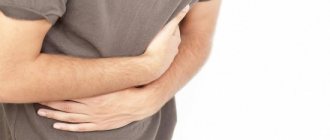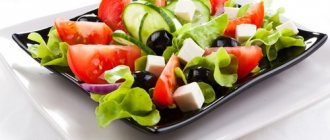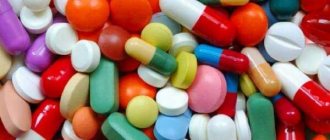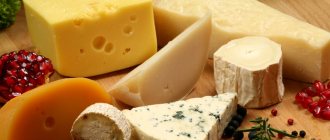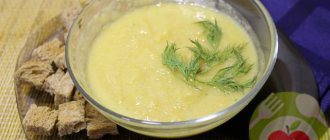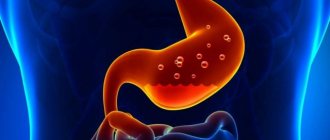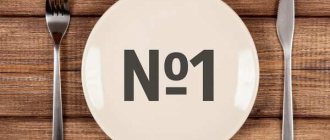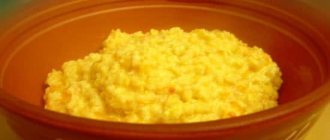Why does the doctor prescribe a diet?
Pancreatitis involves the development of an inflammatory process in the pancreas, which is a consequence of the abuse of fatty and fried foods, carbonated and alcoholic drinks. The diet is prescribed by a doctor to reduce the load on the gland.
Pancreatitis is often accompanied by gastritis, which involves inflammation of the gastric mucosa. The result of this is a disruption in the production of hydrochloric acid, which affects the digestive processes. To reduce inflammation, you need to follow a diet that the doctor prescribes to the patient.
Diet is an important component of the treatment of gastritis and pancreatitis. To reduce the load on inflamed organs, a number of products are excluded from the menu.
What you can and cannot eat with cholecystitis and pancreatitis
Diet for atrophic gastritis of the stomach and menu for the week
Diet for cholecystitis and pancreatitis implies a number of prohibitions. Some products are completely excluded from the menu. Even their one-time use is unacceptable. Another category of food is the basis of the diet.
When creating a menu, it is important to consider that one serving should not exceed 250 g, and meals are taken at least five times a day
Prohibited Products
There is a specific list of foods that should not be consumed during inflammatory processes in the gallbladder and pancreas. Violation of the diet can cause exacerbation of pathologies. In addition to prohibited products, fast food dishes should be excluded from the menu - semi-finished products, cereals and soups brewed in boiling water, fast food. Fatty, fried, salty and spicy foods are also prohibited.
List of prohibited products:
- cheese of salty and spicy varieties;
- dairy products with a high percentage of fat content;
- fried pies, puff pastries and pastries;
- cold soups and rich meat first courses;
- sour varieties of fruits and berries;
- ice cream, chocolate, cream cakes;
- smoked and salted fish;
- canned meat and fish;
- mushrooms and mushroom broths;
- boron or cabbage soup from sorrel;
- meat and fish of fatty varieties;
- sorrel, radish, cabbage, radish;
- onion and garlic;
- peas and beans;
- salo;
- carbonated drinks;
- alcohol.
Allowed dishes
When compiling a dietary menu, it is important to take into account the recommended methods of preparing dishes (cooking, stewing, steaming). You can cook food only on the basis of the list of permitted products
Additionally, the individual characteristics of the body should be taken into account.
List of allowed dishes and products:
- porridge with diluted milk;
- vegetarian soups;
- low-fat boiled fish (or fish cutlets, steamed meatballs);
- fermented milk products with a low fat content (ryazhenka, kefir, cottage cheese);
- buckwheat and oatmeal;
- vegetable pilaf;
- steam omelette (from egg whites);
- lean meat in the form of meatballs, cutlets (rabbit, turkey, beef, pork, chicken);
- lean meat and fish baked in foil;
- vermicelli and other pasta;
- non-acidic varieties of berries and fruits (compotes, jelly based on them);
- cottage cheese, cereal or vegetable casseroles;
- stewed vegetables (including vegetable stew);
- biscuits and unsalted crackers;
- dried rye bread;
- rosehip decoction;
- green and herbal tea.
Video on the topic: Stones in the Gall Bladder. Do's and Don'ts!
Can I eat dairy products?
Consumption of milk-based products for cholecystitis and pancreatitis implies several important rules. Such products can be introduced into the menu only after an attack of exacerbation of the inflammatory process has stopped. Dairy products should have a reduced fat content. Whole milk is completely excluded from the diet.
The following types of dairy products should not be consumed:
- ice cream;
- condensed milk;
- baked milk;
- new milk.
Is it possible to eat pumpkin dishes?
When treating pancreatitis and cholecystitis, pumpkin must be present in the diet. The product has a number of beneficial properties for the pancreas and gall bladder. You can prepare pumpkin dishes in steamers, multicookers, by boiling, stewing or baking. You can use it as a main or additional ingredient.
Examples of pumpkin dishes:
- pudding;
- dessert;
- cream soup;
- rice with pumpkin;
- pumpkin porridge.
Nuts for the considered pathologies
Nuts contain a huge amount of useful substances. For cholecystitis and pancreatitis, this product is not only allowed, but also recommended for use. An important nuance is that the nuts must be crushed as much as possible (it is best to use a blender or coffee grinder). The product can be added to salads, desserts, or consumed as a mixture of different types of kernels. The daily norm should not exceed 20 g.
Basic Rules
For pancreatitis and gastritis, the basic rules for creating a diet are as follows:
- The diet should be five times a day: first and second breakfast, lunch, afternoon snack and dinner. Portion sizes are reduced.
- Eating dry food on the go is strictly not recommended.
- You should not eat in the last two hours before bedtime.
- Fried foods are excluded from the diet. It contains harmful components that have a detrimental effect on the pancreas.
What to give up
Patients with gastritis and pancreatitis should avoid baking. Borscht and rassolniki, as well as fatty goose and duck meat, and pork are prohibited.
Many vegetables are prohibited, for example, cabbage, which tends to irritate the mucous membranes of organs, as well as radishes and cucumbers. Mushroom-based dishes are limited. Alcohol, soda and any cheese are prohibited.
You should not eat fresh and rye bread, strong tea and coffee, fatty broths, canned food, sausages, and fast food.
What foods can you eat?
All dishes that make up the menu are prepared using products that are easily processed by the gastrointestinal tract. These include the following:
- jelly from non-acidic fruits and berries;
- green and weak black tea, rosehip decoction without sugar;
- steamed chicken egg dishes;
- low-fat broths (based on meat, fish, vegetables);
- fruit and vegetable purees (fruits and vegetables must first be boiled);
- porridge;
- steamed cutlets.
Bread made from premium flour is allowed in moderation, but it is better to replace it with breadcrumbs. From time to time you can treat yourself to a biscuit, but it’s better to eat yesterday’s cake, slightly dried out. Milk is also acceptable in small quantities, but the best alternative is low-fat kefir.
Diet menu for gastritis and pancreatitis
Diseases such as pancreatitis and gastritis have a number of similar symptoms - nausea, vomiting, heaviness in the stomach, indigestion, lack of appetite. After examination, establishment of an accurate diagnosis, choice of therapy, the patient is prescribed diet No. 5. It is quite strict, but satisfies the needs of inflamed organs - the pancreas and stomach.
Nutrition during exacerbation of gastritis and pancreatitis should be thoughtful. The acute phase of the disease is accompanied by severe pain in the back and epigastric region. The patient has a fear of eating food, and often experiences nausea and vomiting. In the treatment of any gastrointestinal pathology, diet is the main therapeutic measure. That is why diet No. 5 implies not only a list of permitted and prohibited foods, but also methods of preparing food, the number of meals, and the daily intake rate.
Therapeutic nutrition for pancreatitis and gastritis
Basic recommendations of diet No. 5:
- Baked, stewed, boiled and steamed dishes are allowed;
- at one time you need to eat no more than 200-250 g of food;
- It is forbidden to eat too cold and hot food;
- the interval between meals should be several hours;
- pasta should be cooked only in water;
- It is unacceptable to use dressings and seasonings in dishes;
- soups should be prepared exclusively with water;
- first courses should be pureed or in the form of puree soup;
- cook porridge semi-liquid;
- You can make steam cutlets from fish or cook it only by steaming;
- from poultry meat you need to prepare steamed cutlets, soufflés, casseroles;
- dairy products must be low-fat;
- vegetables should also be steamed and eaten in small portions;
- Raw fruits are prohibited; it is better to make jellies, mousses, and jelly from them;
- It is allowed to prepare decoctions, compotes, and jelly from drinks;
- For sweets, you can eat jam, marshmallows, and marshmallows in small quantities.
Attention! Patients with chronic pancreatitis and gastritis in remission are prescribed diet No. 5B. It is characterized by a reduced fat content - up to 70-80 g per day.
Thus, therapy for pancreatitis and gastritis with diet involves certain foods. Limiting the consumption of prohibited foods will benefit many other diseases of the digestive tract. A steamer and blender can help in organizing proper nutrition. With this diet, you don’t have to worry about exacerbation of gastritis and pancreatitis.
What you can do on a diet for gastritis and pancreatitis
Patients with exacerbation of gastritis and pancreatitis must constantly adhere to a diet, monitor nutrition, the composition of dishes, and the frequency of meals. At the same time, it is important to consume permitted food products only when properly processed. Absolutely healthy people should adhere to the same recommendations.
Foods for gastrointestinal diseases
Gastroenterologists recommend using the following foods for diet during exacerbation of diseases:
- lean meat and fish, chicken, rabbit, turkey, boiled or steamed;
- first courses without rich broth, you can add cereals and vermicelli;
- whole grain yesterday's bread, biscuits;
- sunflower and butter in small volumes;
- cereals include buckwheat, oatmeal, crushed egg, semolina, rice;
- baked vegetables - tomatoes, potatoes, pumpkin, cauliflower, zucchini, carrots;
- eggs boiled or in the form of an omelet;
- dairy products with a small percentage of fat content;
- sweet ripe fruits are allowed;
- honey, jam, marshmallows in small quantities.
Recommended reading: Benefits of tomatoes for the body
Important! During diagnostic studies, acidity should be clarified. Based on this, some nuances of the diet may change.
What not to do on a diet for gastritis and pancreatitis
It is worth mentioning foods prohibited for consumption during exacerbation of gastritis and pancreatitis. These include all fatty, salty, fried foods, all types of mushrooms, seeds and nuts. You should refrain from eating cabbage, sorrel, spinach, radish, radishes, and legumes. Coffee, tea, alcohol, spices and seasonings, as well as smoked products, marinades and preserves are prohibited.
Sample menu for the week
Despite the fact that with gastritis and pancreatitis many foods need to be excluded, the menu can be quite tasty and varied. It must be drawn up by a doctor. Below is an example of a weekly diet.
Monday
- Breakfast: pilaf based on dried fruits;
- Second breakfast: biscuits and tea;
- Lunch: vegetable soup (with grated carrots and pumpkin), fish soufflé, currant broth;
- Afternoon snack: strawberries and low-fat milk;
- Dinner: eggplant and zucchini stew with boiled veal, a glass of compote.
Tuesday
- Breakfast: cheesecakes;
- Second breakfast: a couple of baked apples;
- Lunch: soup with chicken breast and noodles, baked zucchini, rosehip infusion;
- Afternoon snack: jelly;
- Dinner: baked fish, milk jelly.
Wednesday
Breakfast: buckwheat;- Second breakfast: cottage cheese with sour cream;
- Lunch: soup with rice based on vegetable broth, beef cutlet, tea;
- Afternoon snack: kefir;
- Dinner: chicken soufflé, jelly.
Thursday
- Breakfast: oatmeal;
- Second breakfast: soft-boiled egg;
- Lunch: vegetable puree soup, lean baked meat, a cup of tea;
- Dinner: boiled pollock, rosehip infusion.
Friday
- Breakfast: steamed omelette;
- Second breakfast: rosehip broth;
- Lunch: fish soup, beef dumplings with cottage cheese, tea;
- Afternoon snack: milkshake with strawberries;
- Dinner: pasta and broccoli casserole, jelly.
Saturday
- Breakfast: rice porridge with milk;
- Second breakfast: biscuits with tea;
- Lunch: vegetable soup, turkey chops, a small amount of marshmallows;
- Afternoon snack: beetroot and carrot puree with the addition of sea buckthorn;
- Dinner: steamed fish cutlets, currant broth.
Sunday
- Breakfast: poached egg;
- Second breakfast: pie with jam and tea;
- Lunch: vegetable soup, meat and egg roll, tea;
- Afternoon snack: smoothie with raisins and oatmeal;
- Dinner: boiled fish, rosehip broth.
Video on the topic: Nutrition for gastritis - basic rules of various forms.
Herbal decoctions for pancreatitis and gastritis
Various herbal decoctions, which have been used since ancient times, relieve inflammation and heal, so they can be used for gastritis and pancreatitis. Decoctions and teas are prepared from medicinal plants. Plants such as rose hips, plantain, yarrow, and St. John's wort have proven themselves well. It is better to use them diluted.
You should be wary of ready-made herbal teas sold in pharmacies. They may contain seasonings that are undesirable in inflammatory processes. Also keep in mind that any medicinal plant can provoke an allergic reaction.
Recipes for preparing dietary dishes for pancreatitis
If you have pancreatitis or cholecystitis, you should not completely give up foods, but reasonable measures are required in your diet. If the disease has transitioned from a chronic to an acute stage, then the above list of products should not be consumed! As your health condition normalizes, during remission of pancreatitis, you can consume a little of your favorite product.
Vegetable soup with cheese meatballs
After softening the butter, grating the cheese, mix them, add egg, flour, herbs, and salt to the total mass. Then mix and leave in the refrigerator for 30 minutes. Place water on the fire and bring it to a boil. At this time, grate the carrots on a coarse grater and cut the bell pepper into small slices.
Potatoes and onions should be cut into cubes. Place the resulting vegetable ensemble in boiling water and wait for about fifteen minutes. Then remove the mixture from the refrigerator. Roll small balls out of it. Place them in a container with soup, stir, and cook for another fifteen minutes.
As your health status normalizes during remission of pancreatitis, you can consume a little of your favorite product
To prepare soup with cheese meatballs you will need:
- water or vegetable broth - 2.5 liters;
- bell pepper, carrots, onion (medium), egg - 1 pc.;
- potatoes – 5 pcs.;
- mild cheese (Dutch) – 100 grams;
- flour – 100 grams; a little salt, butter, herbs.
Potato cutlets with sausage
Boil the potatoes, cool, grate them. Finely chop the sausage and grate the cheese. Combine these ingredients, add raw eggs, chopped onions, and herbs to the container. Then put two tablespoons of flour into a common container and add salt. Roll parts of the resulting mixture into cutlets, dip in breadcrumbs, and cook in a double boiler. When ready, add sour cream.
To prepare potato cutlets with sausage you will need:
- potatoes (medium) – 7 pieces;
- onion – 1 pc.; hard cheese – 200 grams;
- milk sausage – 250 grams; egg – 3 pcs.;
- flour - 3 tablespoons; sour cream and herbs - a little.
Potato omelet from a steamer
Grate the boiled potatoes. Take another container and beat eggs, milk with salt and spices in it. In a double boiler, cover the bowl with cling film, place a layer of potatoes on it, and pour the liquid mixture from the second container on top. Sprinkle grated cheese and herbs on top. Wait until the dish is ready (about half an hour). Bon appetit!
To prepare you will need:
- boiled potatoes – 200 grams;
- egg – 4 pcs.; milk – 100 ml;
- hard cheese – 50 grams; spices; greenery.
Enzymes
Enzymes help the digestive organs cope with their direct functions. Gastritis and pancreatitis are precisely the reason for their lack. Special medications, the choice of which in pharmacies is extremely wide, can fill the gap. A popular medicinal enzyme is pancreatin. It is part of such drugs as Mezim, Festal and Creon.
Complications possible if the diet is not followed
As a complication of gastritis, stomach ulcers, duodenal ulcers, and bleeding from the gastric mucosa can sometimes occur. These conditions may manifest as bloody vomiting. The next manifestation is anemia, leading to increased fatigue, pallor, and dizziness.
Some types of the disease, especially chronic atrophic gastritis, are among precancerous diseases with a risk of transforming into cancer.
Less is said about pancreatitis. But this is a serious disease that can cause not only long-term consequences, but even (in the worst case) death of the patient.
Features of the diet during exacerbation
When pathologies worsen, the menu is slightly adjusted. One day a week should be devoted to therapeutic fasting. The next day, it is recommended to have a light breakfast, for example, oatmeal with water. Then you can eat as usual.
Complications possible if the diet is not followed
Proper nutrition for gastritis and pancreatitis helps normalize digestive processes and promote healing. If you do not follow the recommendations of a specialist and regularly violate the proposed menu, then there is a risk of pathologies becoming chronic or even oncological. The sooner you start treating diseases, the better - this way you can avoid many negative consequences.
Cooking tips
Proper nutrition for gastritis and pancreatitis means proper preparation of recommended products.
The diet for patients with gastrointestinal diseases includes recipes for steamed, stewed, boiled, baked dishes.
During the cooking process, food is chopped, pureed, and beaten. For soups, “second” broths are used, or strong meat broth is diluted with water and vegetable broth in a 1:1 ratio. Inflammations of the gastric mucosa are relieved with liquid oatmeal porridge.
Soups with low acidity
The diet for gastritis includes pureed mucous first courses of rice, oatmeal and water. Liquid or puree soups for patients with gastritis and pancreatitis are prepared on the basis of vegetable or weak meat broths. To add variety to your diet, lean beef, veal, chicken, rabbit or turkey can be served in meatball form. The use of pasta is allowed.
What can you eat with pancreatitis? Nutrition for gastritis - basic rules of various forms
General tips for organizing nutrition for pancreatitis and gastritis
Pathologies are not only acute and chronic. There is gastritis with high and low stomach acidity, and this will also affect nutrition. With high acidity, you need food that improves the production of gastric juice. At low levels, you need to avoid those products that can further damage the irritated mucous membrane. The main goal of a therapeutic diet is to give the stomach and pancreas maximum rest.
There are also the following rules for creating a diet:
You need to eat in small portions.- Food can be steamed, stewed and boiled. Frying is excluded.
- Food should be moderately warm, never cold or hot.
- During an attack of gastritis, food should be pureed.
- You need to eat slowly, chewing your food thoroughly.
- It is recommended to eat at the same time every day.
Delicious recipes for pancreatitis
The most basic condition in the treatment of a disease such as pancreatitis is mandatory adherence to a diet. For the first time after an acute attack (2-3 days), it is recommended to avoid eating altogether and fast. It should be noted here that the body usually itself “knows” that it is necessary to wait a while with food, and therefore a patient with acute pancreatitis very rarely experiences an appetite.
Snowballs with fruit sauce
The egg white must be beaten to a thick foam and gradually, without stopping whisking, add vanillin and 15 g of sugar. Then spoon the whipped egg white into a deep pan filled with boiling water. After a few minutes, turn the snowballs over, close the lid and let them stand for a while (5-6 minutes), then be sure to take them out, place them on a sieve and let the water drain. Pour the resulting snowballs with sauce made from strawberries, potato flour and sugar (10 g).
You will need for cooking: half an egg white; 25 grams of sugar; 50 grams of strawberries; 10 grams of potato flour; 100 grams of water a pinch of vanillin.
Vegetable stew
If you follow your doctor's recommendations, strictly follow the diet and follow all instructions, you can quickly achieve relief.
Cut potatoes and pumpkin into cubes. Chop carrots and onions. Place all the vegetables in the pan: the first layer is onion, then, one by one, potatoes, pumpkin and carrots. Add a little salt, add water to about half the volume and cook over low heat. Then, at the very end, add vegetable oil, herbs, bring to a boil, turn off and let stand for a while
You will need for cooking: 5 potatoes; the same amount of pumpkin (by volume); 1 carrot; 1 onion; 2 tbsp. spoons of vegetable oil; dill or parsley.
Vermicelli casserole
Cook the vermicelli in salted water until tender, place in a sieve and cool. Then put the grated cottage cheese, beaten egg in milk, sugar into the chilled vermicelli and mix gently. Grease the pan with oil, spread the mixture and bake in the oven, making sure that a brown crust does not form on top. If you suddenly miss the moment, remove the crust of the casserole with a sharp knife.
You will need for cooking: 30 grams of vermicelli; 30 grams of milk; 7 grams of sugar; 35 grams of cottage cheese; 1/4 part of an egg.
Pike perch in foil
Cut the fillet into portions, add a little salt and place each piece on a separate sheet of foil. Grate the carrots on a fine grater, finely chop the onion, sprinkle it with lemon juice. Place a small piece of butter (0.5 teaspoon), chopped carrots and onions on the fish. Fold the edges of the foil so that its top does not touch the onion, place the balls on a baking sheet and place in a hot oven (180-200 degrees) for 30 minutes. Sprinkle the finished fish with herbs on top.
You will need: 600 grams of pike perch fillet; 1 carrot; 1 onion; 1 tbsp. spoon of butter; 2 tbsp. spoons of lemon juice, herbs.
Sources:
- https://hochu.ua/cat-health/diet-and-nutrition/article-80560-provereno-dieta-dlya-podzheludochnoy-zhelezyi-kotoraya-stanet-nastoyaschim-spaseniem/
- https://diet-diet.ru/diety/dieta-pri-lechenii-pankreatita-podzheludochnoj-zhelezy.html
- https://www.passion.ru/diet/effektivnye-diety/dieta-pri-pankreatite-51019.htm
- https://sovets.net/3158-dieta-pri-pankreatite-i-kholetsistite.html
- https://gastritinform.ru/www.aif.ru/boostbook/pitanie-pri-pankreatite.html
- https://gastritinform.ru/www.pravilnoe-pokhudenie.ru/dieta-pri-pankreatite.shtml
Sample menu
The diet for gastroduodenitis and the menu for the week are given below. The menu is conditional; it is allowed to use other products and dishes permitted by the list.
The diet consists of 5-6 meals a day. It must be chewed thoroughly. Long breaks in eating (4 hours or more) are unacceptable. Food is taken every 2.5-3 hours.
- Breakfast: oatmeal porridge, mineral water.
- Second breakfast: soft-boiled egg.
- Lunch: milk soup with thin noodles, steamed chicken cutlets, apple broth.
- Afternoon snack: pureed buckwheat porridge, apple decoction.
- Dinner: semolina porridge with water, tea with low-fat milk.
- Breakfast: boiled lean fish, oatmeal, apple broth.
- Second breakfast: baked apple.
- Lunch: pureed buckwheat soup, steamed meat cutlets, pureed egg, tea with the addition of low-fat milk.
- Afternoon snack: dried wheat bread, marshmallows – 1 pc.
- Dinner: mashed potatoes with boiled carrots, tea with low-fat milk.
- Breakfast: cottage cheese with honey, tea with milk, oatmeal with milk.
- Second breakfast: baked apple or applesauce.
- Lunch: vegetable broth soup with pureed vegetables, a piece of boiled pollock, pureed egg, tea with low-fat milk.
- Afternoon snack: cottage cheese with honey, jelly.
- Dinner: semolina porridge with water, tea with low-fat milk.
- Breakfast: cottage cheese with a teaspoon of honey, oatmeal, tea with low-fat milk.
- Second breakfast: apricot juice, dry biscuits.
- Lunch: mashed egg soup, steamed hake cutlets, wheat crackers, tea with low-fat milk.
- Afternoon snack: grated carrots with beets.
- Dinner: chicken soufflé, pureed buckwheat porridge, tea with low-fat milk.
- Breakfast: two soft-boiled eggs, oatmeal with mashed banana, tea with low-fat milk.
- Second breakfast: carrot soufflé, chicory with the addition of low-fat milk.
- Lunch: oatmeal soup with milk, boiled minced chicken with pureed kernels, tea with low-fat milk.
- Afternoon snack: apricot juice, cottage cheese soufflé.
- Dinner: semolina porridge with milk, tea with low-fat milk.
- Breakfast: buckwheat porridge pureed in milk, baked apple, chicory with milk.
- Second breakfast: boiled grated carrots with sugar.
- Lunch: buckwheat soup with pureed turkey, veal or beef meatballs, mashed potatoes, apple broth.
- Afternoon snack: sweet cottage cheese, tea with low-fat milk.
- Dinner: baked hake, pureed buckwheat, apple broth.
- Breakfast: marshmallows, dry cookies, cottage cheese with honey, tea with low-fat milk.
- Second breakfast: baked apple with cottage cheese.
- Lunch: baked fish without crust, mashed potatoes with butter, oatmeal soup, endive with milk.
- Afternoon snack: chicken breast soufflé.
- Dinner: apricot juice, 2 soft-boiled eggs, semolina porridge with milk.
These are the dishes you can include on the menu for gastroduodenitis. The food, despite the restrictions, will not seem meager or tasteless.
Diet food recipes
So, what recipes for dishes for patients with pancreatitis and gastritis will be useful? In order for cooked food to bring truly significant benefits to the body, you must carefully listen to the recommendations of a gastroenterologist and nutritionist and be sure to follow the technology for preparing medicinal dishes.
We offer a selection of prescription options with which you can perfectly diversify the diet of a sick person.
Cauliflower soup
Light cauliflower soup is perfect for dietary nutrition. To prepare it you need to take the following products:
- Cauliflower – 200 g.
- Egg – 1 pc.
- Water – 1 l.
- Milk – 200 ml.
- Sugar - to taste.
- Salt – a pinch.
- Sour cream – 1 tbsp.
Sort the cabbage, rinse well, divide into inflorescences and boil in lightly salted water until tender, then pull out the vegetable.
Rub the cabbage through a sieve or puree in a blender. Add sugar and milk to the resulting mass, mix and put on fire. Separately, combine sour cream and egg, stirring until smooth.
As soon as the soup begins to boil, slowly pour in the sour cream and egg liquid, stir and immediately turn off the heat. Serve warm.
Meatballs with carrot garnish
Meatballs are prepared from turkey, chicken or veal. From the products you need to take:
- Meat – 300 g.
- Carrots – 1 pc.
- Dill greens - to taste.
- Salt – a pinch.
Rinse the meat, grind 2 times through a meat grinder. Add some chopped herbs and salt to the minced meat.
Form small balls from the finished minced meat. Bring the water to a boil and use a spoon to lower the meatballs into it. Cooking time is 20 minutes.
Peel the carrots, rinse and chop them on a fine grater, place them in a saucepan, add a little water and simmer until soft. Add the meatballs, simmer for a couple more minutes and serve.
Vareniki
Dumplings prepared according to this recipe are ideal for breakfast.
Required ingredients:
- Cottage cheese – 150 g.
- Egg – 1 pc.
- Flour – 1 tbsp.
- Sugar – 1.5 tbsp.
First rub the cottage cheese through a sieve. Combine with the rest of the products and knead the curd mass. Roll out into a sausage shape and cut into even pieces. Boil in lightly salted water until tender.
Before use, if desired, top with sour cream or butter melted in a water bath.
Vegetable salad
This salad can be consumed for gastritis with high acidity. The following products will be required:
- Carrot – 1 pc.
- Beets – 1 pc.
- Potatoes – 2 pcs.
- Peas (canned) – 1 jar.
- Dill - to taste.
- Vegetable oil – 1-2 tbsp.
- Salt – a pinch.
Boil all vegetables except peas until soft, and then chop. Finely chop the dill. Combine all ingredients, add oil, mix.
Diet Olivier
For pancreatitis and gastritis, the popular Olivier salad falls into the category of forbidden food due to the presence of mayonnaise and pickles in it. However, it can be prepared according to the dietary version. To prepare you need to take:
- Potatoes – 2 pcs.
- Chicken fillet – 150 g.
- Carrots – 1 piece.
- Low-fat sour cream (yogurt) – 2-3 tbsp.
- Greens and salt - to taste.
- Boiled peas – 70 g.
Boil the meat until cooked, also boil the carrots and potatoes. Cut the prepared vegetables and meat into small cubes, and finely chop the greens.
Combine all prepared products, add peas and sour cream, mix, add a pinch of salt if necessary.

